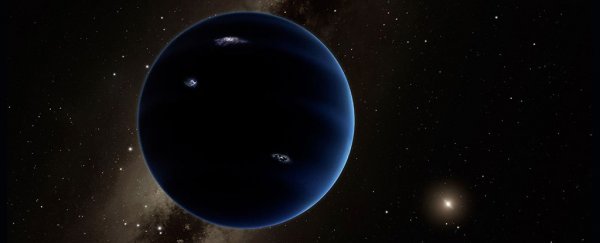Planet Nine is proving difficult to pin down.
The mysterious hypothetical planet, somewhere beyond the orbit of Pluto, has so far evaded all our efforts to find it. We get it. It's very dark, very cold, and very far away, none of which is conducive to detection. And we have only a vague notion about where it might be. There's a lot of sky out there, and only one dark mote.
There are several possible reasons for this. We just haven't seen it yet is one. Another is the very real possibility that it's just not there. Or it might not be a single planet at all, but a swarm of rocks.
Or, according to new research conducted by physicists Katherine Brown of Hamilton College and Harsh Mathur of Case Western Reserve University, what we have interpreted as evidence of a planet could instead be a sign that something is missing from our current model of gravity as described under general relativity.
According to their recent study, the subtle abnormalities in the orbits of various objects some attribute to a hidden planet are also consistent with a different kind of gravitational model – one called Modified Newtonian Dynamics (MOND).
Newton's laws are useful things, there's no doubt. But they aren't exactly perfect. The flaws in Newton's law of universal gravitation were resolved by Einstein's theory of general relativity. MOND is an alternative solution that proposes other gravitational effects take over when Newtonian gravitational acceleration drops below a certain threshold.
Because MOND can describe the gravitational behavior of galaxies that doesn't seem to be tied to normal matter – unexpected rotation curves and lensing effects – it's an attractive alternative to dark matter. But it hasn't really been studied on smaller scales.
"MOND is really good at explaining galactic-scale observations," Mathur says. "I hadn't expected that it would have noticeable effects on the outer Solar System."
The existence of Planet Nine has been inferred based on some strange orbital clustering observed in the outer Solar System. There, enormous numbers of small icy rocks can be found, on large circumsolar paths. The way some of these rocks have been observed clumping together in their orbits could suggest they have been herded by the gravitational influence of a large planet.
Brown and Mathur thought that these clustering observations might not be compatible with MOND. They undertook an investigation, modeling the orbits of outer Solar System Kuiper Belt objects under MOND to observe how they behave.
Surprisingly, what they ended up with was a bunch of rocks behaving pretty much exactly like the observed clustering. Their calculations suggest under MOND theory, some of the objects in the outer Solar System should be dragged into alignment with the gravitational field of the Milky Way galaxy over time.
It's not enough to confidently assert that MOND is responsible for the strange behavior of these distant rocks, rather than a planet. We just don't have enough data, either way. It does throw MOND into the mix of the things that could be out there instead of Planet Nine, though. Dynamical simulations would allow for a more detailed probe of the MOND hypothesis, and help cement it, or rule it out.
"Regardless of the outcome," Brown says, "this work highlights the potential for the outer solar system to serve as a laboratory for testing gravity and studying fundamental problems of physics."
The research has been published in The Astronomical Journal.
